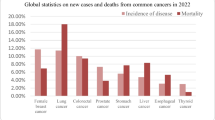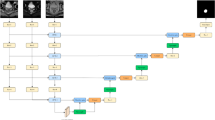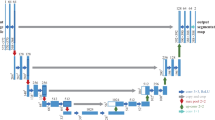Abstract
The precise segmentation of rectal tumors is a key step in the diagnosis and treatment of rectal cancer. This paper aims to study the automatic segmentation task of rectal tumors based on deep learning methods, and proposes a residual UNet network model that combines spatial attention and channel attention. The model uses residual convolution for feature extraction, and uses squeeze-and-excitation module and attention gating module to focus on more useful features. In this study, we established a rectal tumor dataset for model evaluation, and used a combination of two-class cross-entropy and DICE loss function in the training process. Comparative experiments show that the DICE similarity coefficient is 0.8476, the Hausdorff distance reaches 9.5622, the prediction accuracy of the model is 0.9938, and the evaluation indicators are better than the segmentation results of UNet and AttUNet, which can effectively segment the rectal tumor area, and the combined loss function can also improve the segmentation accuracy by about 15% to a certain extent.





Similar content being viewed by others
References
Chen K, Franko K, Sang R (2021) Structured model pruning of convolutional networks on tensor processing units. arXiv:2107.04191
Çiçek Ö, Abdulkadir A, Lienkamp SS, Brox T, Ronneberger O (2016) 3D U-net: learning dense volumetric segmentation from sparse annotation. In international conference on medical image computing and computer-assisted intervention. Springer, Cham. 424–432
Ciresan D, Giusti A, Gambardella L, Schmidhuber J (2012) Deep neural networks segment neuronal membranes in electron microscopy images. Adv Neural Inf Proces Syst 25:2843–2851
Fu J, Liu J, Tian H, Li Y, Bao Y, Fang Z, Lu H (2019) Dual attention network for scene segmentation. In proceedings of the IEEE/CVF conference on computer vision and pattern recognition. 3146–3154
Ganin Y, Lempitsky V (2014) N^ 4-Fields: neural network nearest neighbor fields for image transforms. In Asian conference on computer vision. Springer, Cham. pp 536–551
GAO H, ZENG X, PAN D, ZHENG B (2020) Rectal tumor segmentation method based on improved U-net model. Journal of Computer Applications 40(8):2392–2397
Ghosal P, Nandanwar L, Kanchan S, Bhadra A, Chakraborty J, Nandi D (2019) Brain tumor classification using ResNet-101 based squeeze and excitation deep neural network. In 2019 Second international conference on advanced computational and communication paradigms (ICACCP). IEEE. 1–6
Guo Y, Gao Y, Shen D (2015) Deformable MR prostate segmentation via deep feature learning and sparse patch matching. IEEE Trans Med Imaging 35(4):1077–1089
Hu J, Shen L, Sun G (2018) Squeeze-and-excitation networks. In proceedings of the IEEE conference on computer vision and pattern recognition. 7132–7141
Huang Q, Ding H, Wang X, Wang G (2018) Fully automatic liver segmentation in CT images using modified graph cuts and feature detection. Comput Biol Med 95:198–208
Isensee F, Kickingereder P, Wick W, Bendszus M, Maier-Hein KH (2017) Brain tumor segmentation and radiomics survival prediction: contribution to the brats 2017 challenge. In international MICCAI Brainlesion workshop. Springer, Cham. 287–297
Isensee F, Petersen J, Klein A, Zimmerer D, Jaeger PF, Kohl S, ..., Maier-Hein KH (2018) nnu-net: Self-adapting framework for u-net-based medical image segmentation. arXiv:1809.10486
Jian J, Xiong F, Xia W, Zhang R, Gu J, Wu X, Meng X, Gao X (2018) Fully convolutional networks (FCNs)-based segmentation method for colorectal tumors on T2-weighted magnetic resonance images. Australasian physical & engineering sciences in medicine 41(2):393–401
Koonsanit K, Thongvigitmanee S, Pongnapang N, Thajchayapong P (2017) Image enhancement on digital x-ray images using n-clahe. In 2017 10th biomedical engineering international conference (BMEiCON) . IEEE. 1–4
Li S, Zhang Z, Lu Y (2020) Efficient Detection of EMVI in Rectal Cancer Via Richer Context Information and Feature Fusion. In 2020 IEEE 17th international symposium on biomedical imaging (ISBI). IEEE. 1464–1468
Liu S, Yuan X, Hu R, Liang S, Feng S, Ai Y, Zhang Y (2019) Automatic pancreas segmentation via coarse location and ensemble learning. IEEE Access 8:2906–2914
Long J, Shelhamer E, Darrell T (2015) Fully convolutional networks for semantic segmentation. In Proceedings of the IEEE conference on computer vision and pattern recognition. 3431–3440
Lu X, Xie Q, Zha Y, Wang D (2018) Fully automatic liver segmentation combining multi-dimensional graph cut with shape information in 3D CT images. Sci Rep 8(1):1–9
Oktay O, Schlemper J, Folgoc LL, Lee M, Heinrich M, Misawa K, ... U-Net, A (2018) Learning where to look for the pancreas. arXiv:1804.03999, 18
Park YJ, Tuxworth G, Zhou J (2019) Insect classification using Squeeze-and-Excitation and attention modules-a benchmark study. In 2019 IEEE international conference on image processing (ICIP). IEEE. 3437–3441
Pei Y, Mu L, Fu Y, He K, Li H, Guo S, Liu X, Li M, Zhang H, Li X (2020) Colorectal tumor segmentation of CT scans based on a convolutional neural network with an attention mechanism. IEEE Access 8:64131–64138
Ramachandran P, Parmar N, Vaswani A, Bello I, Levskaya A, Shlens J (2019) Stand-alone self-attention in vision models. arXiv:1906.05909
Ran Z, Jian J, Wang M, Zhao X, Gao X (2019) Automatic mri image segmentation of rectal cancer based on full convolutional neural network. Beijing Biomedical Engineering 38(5):7
Ronneberger O, Fischer P, Brox T (2015) U-net: convolutional networks for biomedical image segmentation. In international conference on medical image computing and computer-assisted intervention. Springer, Cham. 234-241
Roth HR, Lu L, Lay N, Harrison AP, Farag A, Sohn A, Summers RM (2018) Spatial aggregation of holistically-nested convolutional neural networks for automated pancreas localization and segmentation. Med Image Anal 45:94–107
Siegel RL, Miller KD, Jemal A (2020) Cancer statistics, 2020. CA Cancer J Clin 70(1):7–30
Sun M, Liang K, Zhang W, Chang Q, Zhou X (2020) Non-local attention and densely-connected convolutional neural networks for malignancy suspiciousness classification of gastric ulcer. IEEE Access 8:15812–15822
Tapan Ü, Özbayrak M, Tatlı S (2014) MRI in local staging of rectal cancer: an update. Diagn Interv Radiol 20(5):390–398
Trebeschi S, van Griethuysen JJ, Lambregts DM, Lahaye MJ, Parmar C, Bakers FC, … Aerts HJ (2017) Deep learning for fully-automated localization and segmentation of rectal cancer on multiparametric MR. Sci Rep 7(1):1–9
Vaswani A, Shazeer N, Parmar N, Uszkoreit J, Jones L, Gomez AN, ..., Polosukhin I (2017) Attention is all you need. In Advances in neural information processing systems. 5998–6008
Wang F, Jiang M, Qian C, Yang S, Li C, Zhang H, ..., Tang X (2017) Residual attention network for image classification. In Proceedings of the IEEE conference on computer vision and pattern recognition. 3156–3164
Wang J, Lu J, Qin G, Shen L, Sun Y, Ying H, Zhang Z, Hu W (2018) A deep learning-based autosegmentation of rectal tumors in MR images. Med Phys 45(6):2560–2564
Wang M, Xie P, Ran Z, Jian J, Zhang R, Xia W, Yu T, Ni C, Gu J, Gao X, Meng X (2019) Full convolutional network based multiple side-output fusion architecture for the segmentation of rectal tumors in magnetic resonance images: a multi-vendor study. Med Phys 46(6):2659–2668
Wolf T, Debut L, Sanh V, Chaumond J, Delangue C, Moi A, ..., Rush, A. M. (2019) Huggingface's transformers: State-of-the-art natural language processing. arXiv:1910.03771
Zheng RS, Sun KX, Zhang SW, Zeng HM, Zou XN, Chen R, Gu XY, Wei WW, He J (2019) Report of cancer epidemiology in China, 2015. Chinese Journal of Oncology 41(1):19–28
Zheng B, Cai C, Ma L (2020) CT images segmentation method of rectal tumor based on modified U-net. In 2020 16th international conference on control, automation, robotics and vision (ICARCV) . IEEE. 672–677
Zhuang Z, Li N, Joseph Raj AN, Mahesh VG, Qiu S (2019) An RDAU-NET model for lesion segmentation in breast ultrasound images. PLoS One 14(8):e0221535
Zulfahmi R, Noviyanti DS, Utami GR, Harison AN, Agung PS (2019) Improved Image Quality Retinal Fundus with Contrast Limited Adaptive Histogram Equalization and Filter Variation. In 2019 International conference on informatics, multimedia, cyber and information system (ICIMCIS) . IEEE. 49–54
Acknowledgments
This work was supported by National Natural Science Foundation of China (Grant No.61971253); Shandong Provincial Natural Science Foundation, China (Grant No.ZR2014FL026).
Author information
Authors and Affiliations
Corresponding author
Ethics declarations
Conflict of interest
We declare that we have no financial and personal relationships with other people or organizations that can inappropriately influence our work, there is no professional or other personal interest of any nature or kind in any product, service, and/or company that could be construed as influencing the position presented in, or the review of, the manuscript entitled is ‘Residual UNet with Spatial and Channel Attention for Automatic Magnetic Resonance Image Segmentation of Rectal Cancer’.
Additional information
Publisher’s note
Springer Nature remains neutral with regard to jurisdictional claims in published maps and institutional affiliations.
Rights and permissions
About this article
Cite this article
Wang, M., Chen, Y. & Qi, B. Residual UNet with spatial and channel attention for automatic magnetic resonance image segmentation of rectal cancer. Multimed Tools Appl 81, 43821–43835 (2022). https://doi.org/10.1007/s11042-022-13256-6
Received:
Revised:
Accepted:
Published:
Issue Date:
DOI: https://doi.org/10.1007/s11042-022-13256-6




